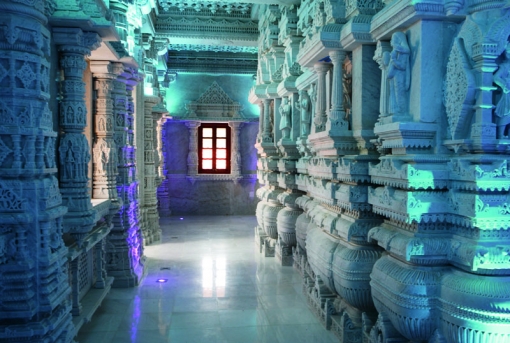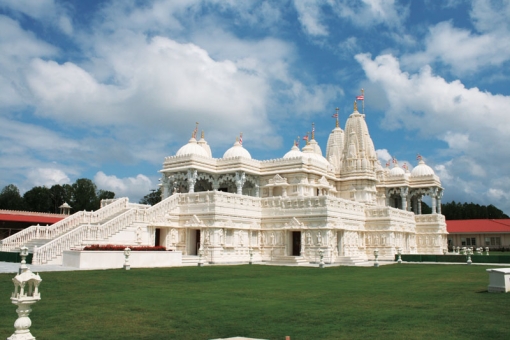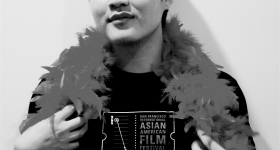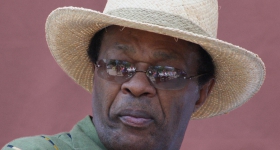In Georgia, the Indian American population more than doubled in the past decade, reaching nearly 100,000 according to 2010 census data. That’s as much as Houston’s Indian American population by raw numbers and faster than the growth rate in Jersey City, NJ, where one of the largest Indian American communities in North America exists. Indian Americans are now the largest group of Asian Americans in the state of Georgia, and the Hindu subset of that group has funded and built seven temples in the Atlanta area alone, including the largest one outside of India. Here is a look at three of these temples.
The Swaminarayan Mandir
In Lilburn, GA, the unmistakable powder-white spires of the Bochasanwasi Shri Akshar Purushottam Swaminarayan Sanstha, popularly known as the BAPS Shri Swaminarayan Mandir, have made national headlines for being part of the largest Hindu temple outside of India. The landmark serves as visual shorthand for the breakneck growth of diversity in Atlanta since the 1996 Olympics. In Sanskrit, the ancient language of holy Hindu texts, mandir means a place of worship. Most people didn’t notice the old mandir, a converted roller skating rink that devotees bought in the ’80s, but the new mandir of marble and limestone lures tourists through the suburban jungle just outside Atlanta and transports them to Gujarat, a state in western India.
Over a thousand skilled craftsmen in India hand-carved the 35,000 marble and limestone pieces that were then shipped to Georgia and assembled like a 3-D puzzle by nearly 900 volunteers, which is greater than the number of attendees some temples have. Many young devotees volunteered and spent their vacations sweating in the humid Southern summer.
Unlike most other Hindus, who practice without the concept of formal membership, Swaminarayan devotees belong to a large international organization with central leadership. Pramukh Swami Maharaj, the guru who leads the BAPS organizations all over the world, has traveled twice to Georgia to perform a puja, blessing the land in 2004 and again in 2007 when the placement of a two-ton keystone in the central dome completed the temple. “Having a spiritual leader like our guru involved at the center of all our activities certainly has helped us,” says Jigar Patel, a 33-year-old emergency room doctor who volunteers as spokesman for the mandir. “Maharaj directs us in terms of activities, classes, community service....The mantra he lives by is: ‘In the joy of others lies our own.’ He is the organization.”
Swami Maharaj is a spiritual successor to BAPS’ founder, Bhagwan Swaminarayan. “Swaminarayan is our god. Not a guru, he’s god,” Patel says. Swaminarayan lived from 1781 to 1830 and initiated 2,000 sadhus, or Hindu monks, in his lifetime. Today, the organization has over 1 million followers and 700 mandirs worldwide. It’s hard to believe after seeing this majestic mandir that there was ever a time when Indians in Georgia had no place to worship.


Over a thousand skilled craftsmen in India hand-carved the 35,000 marble and limestone pieces that were then shipped to Georgia and assembled like a 3-D puzzle by nearly 900 volunteers to create the BAPS Shri Swaminarayan Mandir
The Hindu Temple of Atlanta
When P. Venugopala Rao, a physics professor at Emory University in Atlanta, came to America in 1962 from the state of Andhra Pradesh in southeastern India, there were no temples or priests in Georgia to perform the rites necessary for his 2-year-old daughter according to the Hindu faith.
The Upanayanam, or sacred thread ceremony, for example, is a rite of passage for a school-age child. The child wears a sacred thread made of three strands. As the whole community bears witness, a priest recites the three vows they represent: to respect knowledge, one’s parents and society. Priests train for decades to memorize these epic prayers; a recitation can last hours. Indian immigrants like Rao had no choice but to perform these ceremonies themselves.
Before Google, Rao says, “We’d call India and say to someone, ‘Mail me a worshipping manual immediately, please.’ Now we have all the manuals.”
Rao became the first president of the India American Cultural Association (IACA) serving the greater Atlanta area. IACA founded the Hindu Temple of Atlanta in 1984. The name sounds generic because back then, it was the only Hindu temple in Georgia and needed to serve all Hindus in the state. It was built in the southern Indian style, in which the deities are carved in black granite, but it was shared by Indian immigrants from almost all of the 28 states and speaking most of the 22 languages of India.
Like most Hindu temples in America, this one doubles as a community center, offering language and dance classes. Jayasree Moparthy, also a past president of the Hindu Temple of Atlanta, now chairs the education committee. He explains the religious diversity among Hindus this way: “You’re allowed to visualize God in any way you choose and focus on that manifestation. You’re not condemned just because you came to a personal relationship with God in another form. The sacred cow is no more or less than any other symbol like a sacred river or mountain.”
Many American Hindus hew even closer to tradition than Indian Hindus. “With modernization and international trade, Hinduism in India is changing faster than it is here,” Moparthy says. “For them, it’s day-today life, but it has some nostalgia for us.”
Hindu families generally focus worship on a primary deity. Often, it’s Shiva, Vishnu or the Goddess. At the Hindu Temple of Atlanta, though, Vishnu’s temple is alongside Shiva’s. “It’s a very American thing that the same organization would build both side by side,” anthropologist and Emory University religion professor Joyce Flueckiger says.
In many ways, the predominance of Christianity in the Bible Belt makes it easier for faithful Hindus to practice. “Here, your Baptist neighbor takes religion seriously,” Flueckiger says. Instead of friction, new temples are met with great curiosity, and every temple in this story offers tours conducted by volunteers.
Rao’s daughter eventually got married at the temple her father helped found. People of many faiths came, and the priest didn’t need to check the instruction manual.
The Vedanta Center and United States of India
Some Hindus in Georgia practice in ways that Indians in India might not recognize. Indian Americans in Georgia, unlike people in India, don’t have to leave the state to experience the symbols, rituals and festivals or even architecture of people who practice differently. In fact, Indians in an American city would find it nearly impossible to avoid exposure to temples from other regions of origin. “Multiple choices is the biggest thing that this country offers − even in Baskin-Robbins, there are 32 flavors,” says Dr. Bhagirath Majmudar, who attends the Vedanta Center of Atlanta.
There, only half of the attendees are of Indian origin. The others are Americans coming from many religious backgrounds but who all have an interest in Hinduism. “We have interfaith discussions,” Majmudar says. Monks from other Vedanta Centers, such as the Vedanta Society of Southern California, often come to lecture, but guests from other religions give talks, too.
Most Hindus would find the lack of rituals and the predominance of English at the Vedanta unfamiliar. “This is new Hinduism, but it is true Hinduism,” Majmudar says. “If you go back in Hinduism, there would be one guru with three or four students discussing questions and answers.”
For example: “Buddha did not like some of the things in Hinduism, so he went his own way,” Majmudar says. “That’s a very Hindu thing to do.”
Engaged couples all over the country clamor for Majmudar to perform their Hindu marriage ceremonies. As a lifelong student of Sanskrit, he relishes learning the meanings behind the rituals as much as he enjoys explaining them to diverse wedding guests with the vigor of a professor and a romantic. He has performed nearly 300 weddings, many of them interfaith, interregional and intercaste.
“If I were a classical priest in India, I would be obligated to not approve of an interfaith or even an interclass marriage,” he says. “When I was growing up, people from India were distinctly different by region, but that is being completely obliterated among young people of Indian origin in the United States. I’m very happy to know that here, there’s not so much division. It’s the United States of India.”
Ivy Le is the beer reporter for the Austin Chronicle.









Comments